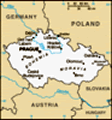Advertisement
The Czech for please is easy, prosim, the Czech for thank-you seems to elude me: dekuji. Everytime I say it, the word just sounds more and more wrong each time. That first sound d'ye with more emphasis on the ye is so challenging for me, and the storekeepers must scratch their heads wondering what I am saying. But I keep trying, and once in a while it sounds somewhat like it should. Some other Czech words are a bit like Russian so that helps me a little. But it's a tough language for me.
Prague is a photogenic city, with lots of spires, ornate building facades, narrow and winding streets and a church on the hill which dominates the skyline. That church is St Vitus church, inside the Prague Castle. The crowds were huge, but I got there at 9am as it opened. As I was leaving the hoards of tour groups started to show. Inside there is some wonderful stained glass; it's all from the 20th Century. There is a Alfons Mucha stained glass as well. His work is so distinctive and gorgeous. Later that day, I went to the Mucha Museum to see his drawings of pretty young
girls in silky flowing gowns with flowers in their hair. 100 years ago, he made advertising posters for the actress Sarah Bernhardt. When Czechoslovakia became a country after 1918 and the collapse of the Austria-Hungarian empire, Mucha designed the money, stamps and medals. You are forgived if you have never heard of Mucha, but I'd be surprised if you have never seen his work somewhere.
The next day, I went to the Museum of Communism, which ironically sits next to a MacDonald's and a casino. An interesting museum with lots of information about life under communist rule. There were displays of kitchens, living rooms, an interrogation room, a few old motorcycles and the obligatory Lenin statue and Marx statue. I stayed and watched a video describing the 21 years of the struggle for freedom, from 1968 to 1989: The Prague Spring to the Velvet Revolution in 1989. A hard fought battle against Moscow, but in the end Prague has become the very antithesis of communism, for there is a MacDonald's on every street corner, independent businesses and so many tourists. And Prague has become the party town of choice for the younger crowd who travel Europe in search of
sex and drugs. (I came for the history.)
I have taken many tram rides through the city, a very enjoyable way to travel. They rumble along stopping less frequently than buses and less frequently for cars. In fact, to the untrained ear, pedestrians should be wary of trams because they don't sound like buses and other cars, all you hear is the low rumble of the metal wheels on the track as the tram approaches, so it's easy to be looking the wrong way standing on the tracks. The rule is, never stand on the tracks. Don't worry, I already knew this rule but I wonder how many uninitiated fall victim to this?
It's a small world as they say. I met someone I know from back home yesterday on the streets near the Charles Bridge. From my old track and field days coaching. We spent some time catching up, because we hadn't seen each other in about 10 years. They are here visiting family. I have crossed the Charles Bridge several times now. It's a pedestrian bridge from about the 15th century, lined with statues, crosses and religious figures. Unfortunately, it's under repair and reconstruction. You can still cross the bridge, but some of it is covered in tarpaulin and scaffolding. Quite a beautiful setting still as the sun sets upon the Castle and St Vitus Church as you cross the bridge. Much of Prague remains as it did from before WWII. This is because the city was spared the airplane bombing that devastated much of Europe. Indeed, only a handful of cities in Europe escaped this bombing. So that's why there are so many narrow and winding streets, ornate building facades, and old buildings. Take out the cars and trams and modern street signs and Prague would make for a wonderful 18th Century movie set.
Last night I attending a Black Light Theatre. It's hard to describe this because we have nothing that compares. It's part ballet, pantomime, and science lesson. Essentially, the stage is lit with a black light, an ultra violet light, and the dancers wear clothing that is fluorescent. They carry objects that are fluorescent as well. And part of this involved some apparently gravity defying tricks because someone behind dressed in black moves the object or lifts the person, but all we can see is the UV lit dancer or object. It's all choreographed to music and very entertaining. In between this scenes was a running gag of a pretend scary movie set, with pretend bad actors and directors. A very entertaining evening.
Advertisement
Tot: 0.538s; Tpl: 0.011s; cc: 36; qc: 130; dbt: 0.4879s; 1; m:domysql w:travelblog (10.17.0.13); sld: 1;
; mem: 1.4mb







